2011 Peugeot 508 wheel
[x] Cancel search: wheelPage 72 of 340
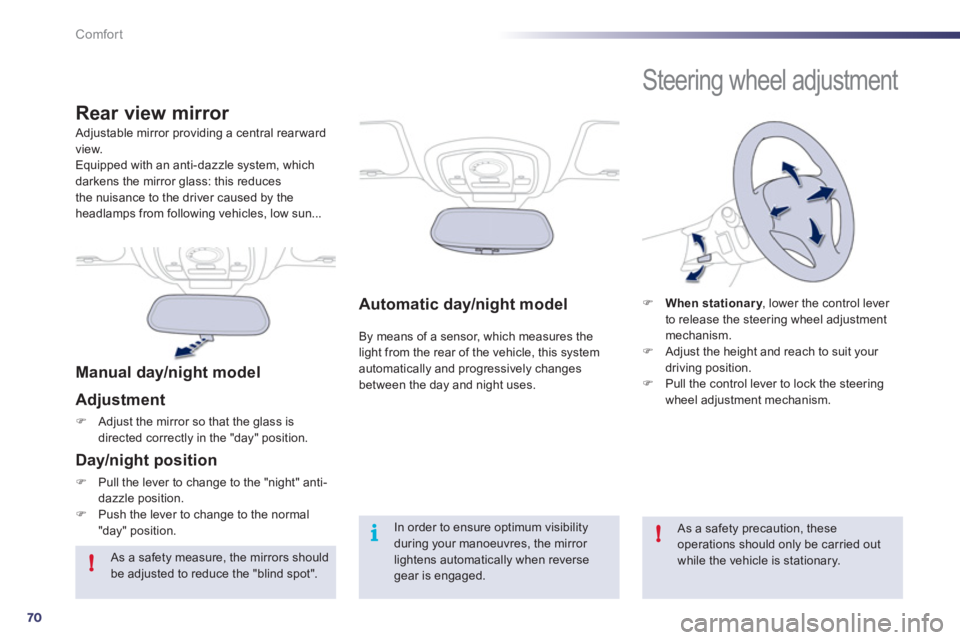
70
!
i!
Comfort
Automatic day/night model
By means of a sensor, which measures the
light from the rear of the vehicle, this system
automatically and progressively changes
between the day and night uses. Adjustable mirror providing a central rear ward
view.
Equipped with an anti-dazzle system, which
darkens the mirror glass: this reduces
the nuisance to the driver caused by the
headlamps from following vehicles, low sun...
Rear view mirror
Manual day/night model
Adjustment
�)
Adjust the mirror so that the glass is
directed correctly in the "day" position.
Day/night position
�)
Pull the lever to change to the "night" anti-
dazzle position.
�)
Push the lever to change to the normal
"day" position.
In order to ensure optimum visibility
during your manoeuvres, the mirror
lightens automatically when reverse
gear is engaged.
Steering wheel adjustment
�)
When stationary
, lower the control lever
to release the steering wheel adjustment
mechanism.
�)
Adjust the height and reach to suit your
driving position.
�)
Pull the control lever to lock the steering
wheel adjustment mechanism.
As a safety precaution, these
operations should only be carried out
while the vehicle is stationary.
As a safety measure, the mirrors should
be adjusted to reduce the "blind spot".
Page 76 of 340
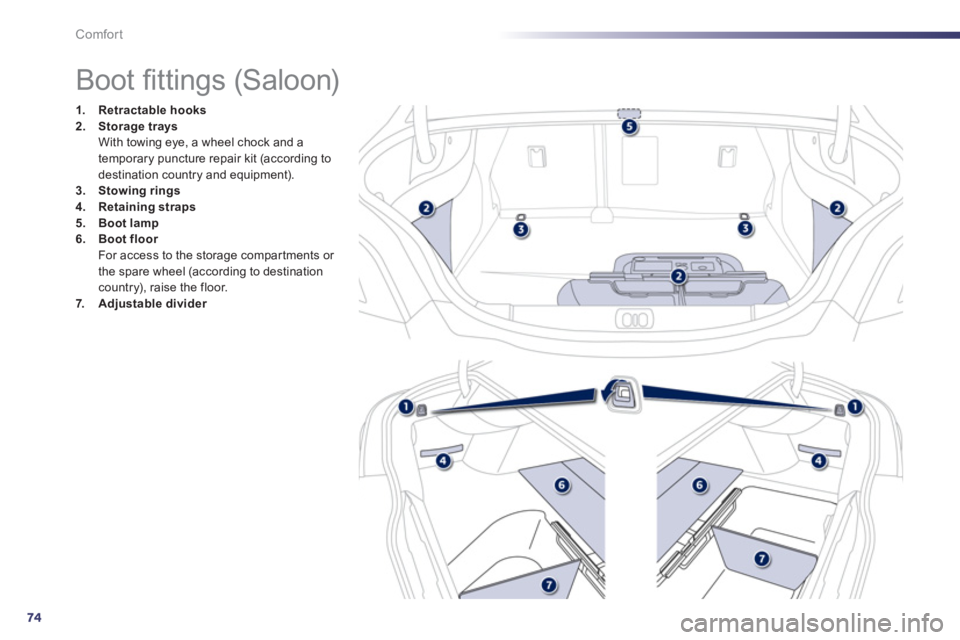
74
Comfort
Boot fi ttings (Saloon)
1.
Retractable hooks
2.
Storage trays
With towing eye, a wheel chock and a
temporary puncture repair kit (according to
destination country and equipment).
3.
Stowing rings
4.
Retaining straps
5.
Boot lamp
6.
Boot floor
For access to the storage compar tments or
the spare wheel (according to destination
country), raise the floor .
7.
Adjustable divider
Page 77 of 340
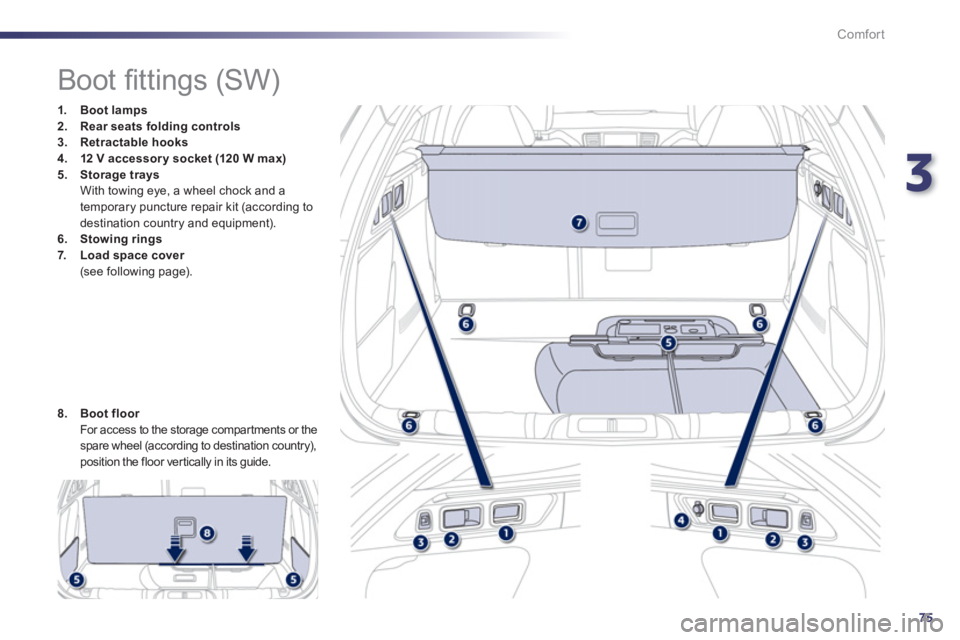
3
75
Comfort
Boot fi ttings (SW)
1.
Boot lamps
2.
Rear seats folding controls
3.
Retractable hooks
4.
12 V accessor y socket (120 W max)
5.
Storage
trays
With towing eye, a wheel chock and a
temporary puncture repair kit (according to
destination country and equipment).
6.
Stowing rings
7.
Load space cover
(see following page) .
8.
Boot floor
For access to the storage compar tments or the
spare wheel (according to destination country),
position the floor ver tically in its guide.
Page 95 of 340
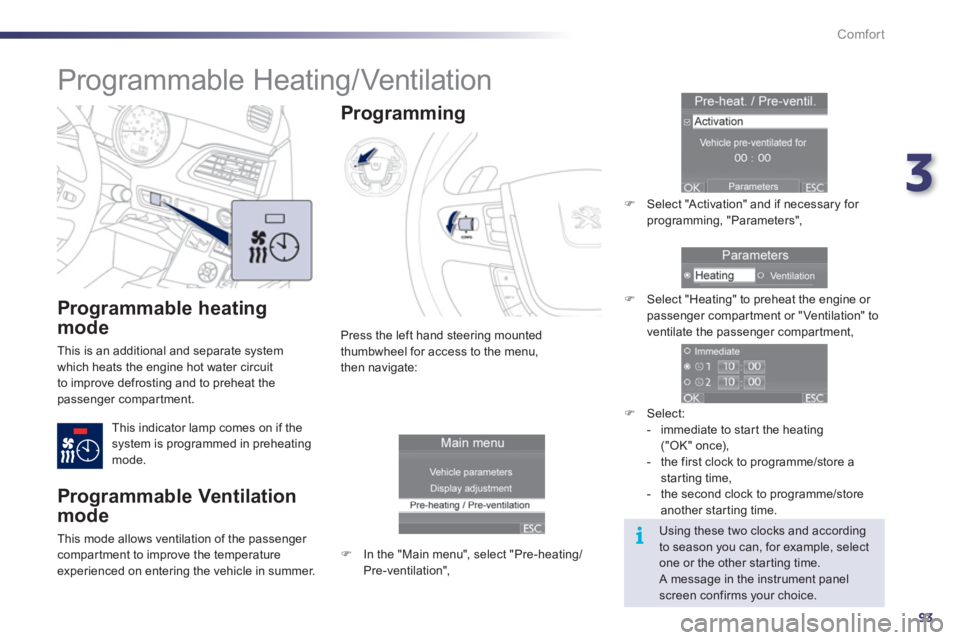
3
93
i
Comfort
Programmable heating
mode
This is an additional and separate system
which heats the engine hot water circuit
to improve defrosting and to preheat the
passenger compartment.
This indicator lamp comes on if the
system is programmed in preheating
mode. Press the left hand steering mounted
thumbwheel for access to the menu,
then navigate:
Programming
�)
In the "Main menu", select "Pre-heating/
Pre-ventilation",
�)
Select "Activation" and if necessary for
programming, "Parameters",
�)
Select "Heating" to preheat the engine or
passenger compar tment or "Ventilation" to
ventilate the passenger compartment,
�)
Select:
- immediate to star t the heating
("OK" once),
- the first clock to programme/store a
starting time,
- the second clock to programme/store
another star ting time.
Programmable Heating/ Ventilation
Programmable Ventilation
mode
This mode allows ventilation of the passenger
compar tment to improve the temperature
experienced on entering the vehicle in summer.
Using these two clocks and according
to season you can, for example, select
one or the other star ting time.
A message in the instrument panel
screen confirms your choice.
Page 96 of 340
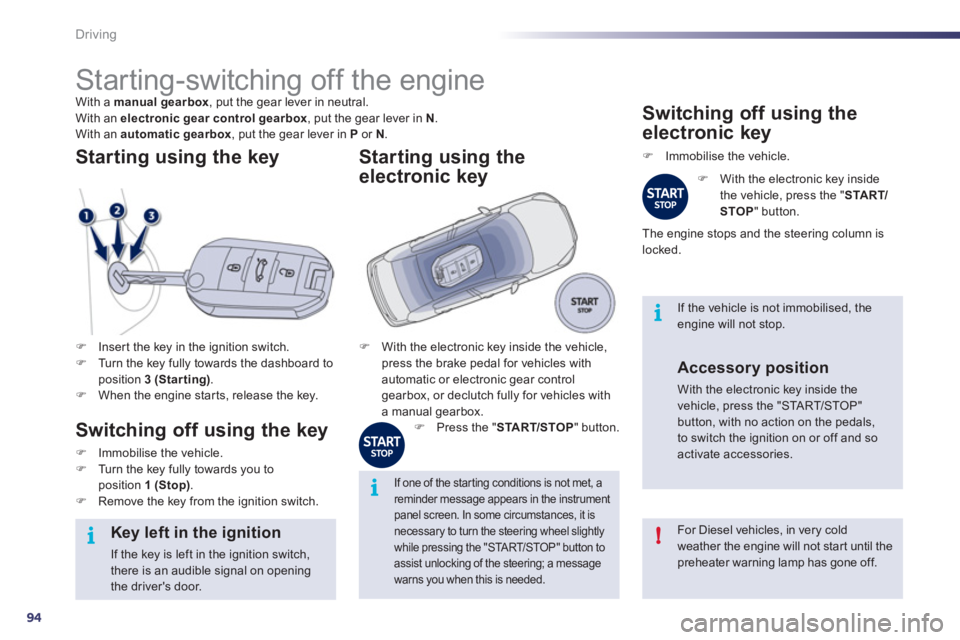
94
i
!
i
i
Driving
Starting-switching off the engine
With a manual gearbox
, put the gear lever in neutral.
With an electronic gear control gearbox
, put the gear lever in N
.
With an automatic gearbox
, put the gear lever in P
or N
.
�)
Inser t the key in the ignition switch.
�)
Turn the key fully towards the dashboard to
position 3 (Star ting)
.
�)
When the engine star ts, release the key.
Starting using the key
Switching off using the key
�)
Immobilise the vehicle.
�)
Turn the key fully towards you to
position 1 (Stop)
.
�)
Remove the key from the ignition switch.
For Diesel vehicles, in very cold
weather the engine will not start until the
preheater warning lamp has gone off.
Key left in the ignition
If the key is left in the ignition switch,
there is an audible signal on opening
the driver's door.
If one of the star ting conditions is not met, a
reminder message appears in the instrument
panel screen. In some circumstances, it is
necessary to turn the steering wheel slightly
while pressing the "START/STOP" button to
assist unlocking of the steering; a message
warns you when this is needed.
If the vehicle is not immobilised, the
engine will not stop.
�)
With the electronic key inside the vehicle,
press the brake pedal for vehicles with
automatic or electronic gear control
gearbox, or declutch fully for vehicles with
a manual gearbox.
Starting using the
electronic key
�)
Press the " START/STOP
" button.
Switching off using the
electronic key
�)
Immobilise the vehicle.
�)
With the electronic key inside
the vehicle, press the " START/
STOP
" button.
The engine stops and the steering column is
locked.
Accessory position
With the electronic key inside the
vehicle, press the "START/STOP"
button, with no action on the pedals,
to switch the ignition on or off and so
activate accessories.
Page 99 of 340

4
97
!
i
Driving
With the ignition on or the engine running,
to release the parking brake, press
the brake
pedal
, pull
then release control lever A
.
The full release of the parking brake is
confirmed by:
Manual release
- extinction of the braking warning
lamp and of the P
warning lamp
in the control lever A
,
- display of the message
"Handbrake off ".
If you pull the control lever A
without pressing
the brake pedal, the parking brake will not
be released and a message appears in the
instrument panel.
If necessary, you can utilise maximum
application
of the parking brake. It is obtained
by means of a long pull
on control lever A
,
until you see the message "Parking brake
applied fully" and an audible signal is heard.
Maximum application is essential:
- in the case of a vehicle towing a caravan
or a trailer, if the automatic functions are
activated but you are applying the parking
brake manually,
- when the slope you are parked on may
vary (e.g. on a ferry, on a lorry, during
towing).
Maximum application
Before leaving the vehicle, check that
parking brake warning lamps in the
instrument panel and in the control
lever A
are on fixed (not flashing).
Never leave a child alone inside the
vehicle with the ignition on, as they
could release the parking brake.
Automatic application,
engine off
- illumination of the braking warning
lamp and of the P
warning lamp in
the control lever A
,
- display of the message
"Handbrake on". With the vehicle stationary, the parking brake
is automatically applied when the engine is
switched off.
The application of the parking brake is
confirmed by:
In the case of towing, a loaded vehicle
or parking on a gradient, make a
maximum application of the parking
brake then turn the front wheels towards
the pavement and engage a gear when
you park.
After a maximum application, the
release time will be longer.
Page 101 of 340
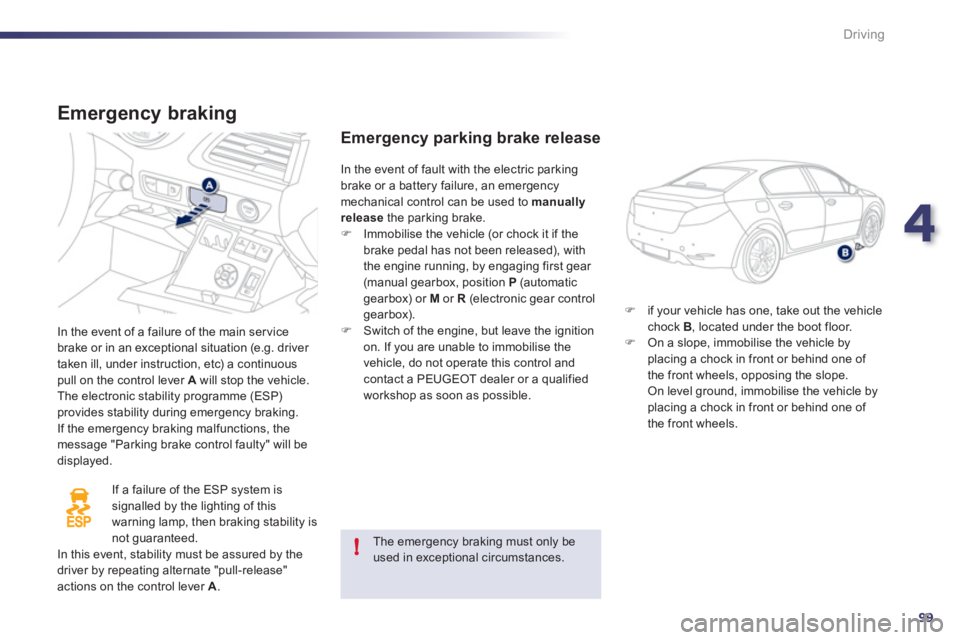
4
99
!
Driving
Emergency braking
In the event of a failure of the main ser vice
brake or in an exceptional situation (e.g. driver
taken ill, under instruction, etc) a continuous
pull on the control lever A
will stop the vehicle.
The electronic stability programme (ESP)
provides stability during emergency braking.
If the emergency braking malfunctions, the
message "Parking brake control faulty" will be
displayed.
If a failure of the ESP system is
signalled by the lighting of this
warning lamp, then braking stability is
not guaranteed.
In this event, stability must be assured by the
driver by repeating alternate "pull-release"
actions on the control lever A
.
Emergency parking brake release
�)
if your vehicle has one, take out the vehicle
chock B
, located under the boot floor.
�)
On a slope, immobilise the vehicle by
placing a chock in front or behind one of
the front wheels, opposing the slope.
On level ground, immobilise the vehicle by
placing a chock in front or behind one of
the front wheels. In the event of fault with the electric parking
brake or a battery failure, an emergency
mechanical control can be used to manually
release
the parking brake.
�)
Immobilise the vehicle (or chock it if the
brake pedal has not been released), with
the engine running, by engaging first gear
(manual gearbox, position P
(automatic
gearbox) or M
or R
(electronic gear control
gearbox).
�)
Switch of the engine, but leave the ignition
on. If you are unable to immobilise the
vehicle, do not operate this control and
contact a PEUGEOT dealer or a qualified
workshop as soon as possible.
The emergency braking must only be
used in exceptional circumstances.
Page 104 of 340
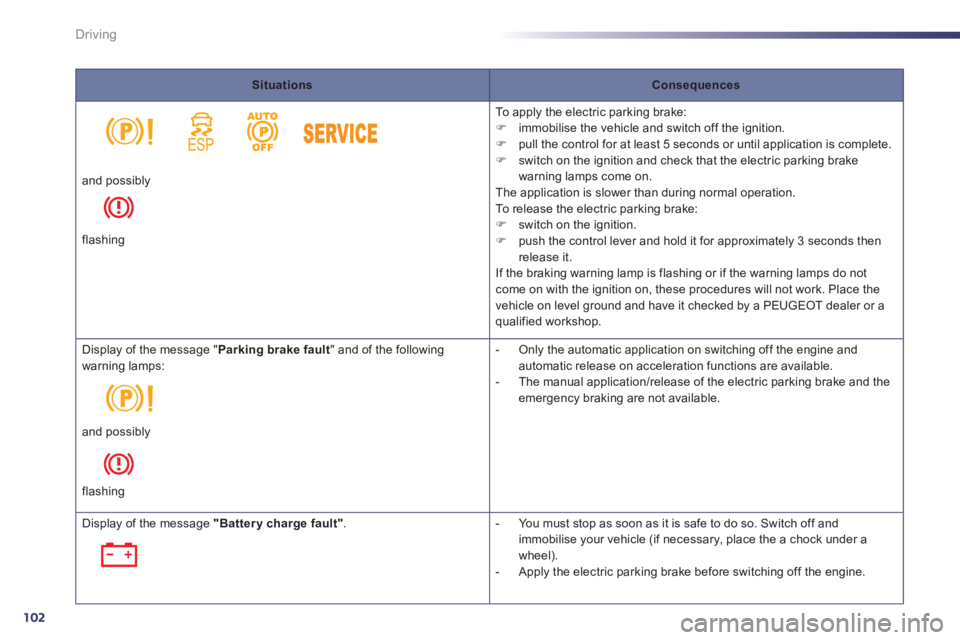
102
Driving
Situations
Consequences
To apply the electric parking brake:
�)
immobilise the vehicle and switch off the ignition.
�)
pull the control for at least 5 seconds or until application is complete.
�)
switch on the ignition and check that the electric parking brake
warning lamps come on.
The application is slower than during normal operation.
To release the electric parking brake:
�)
switch on the ignition.
�)
push the control lever and hold it for approximately 3 seconds then
release it.
If the braking warning lamp is flashing or if the warning lamps do not
come on with the ignition on, these procedures will not work. Place the
vehicle on level ground and have it checked by a PEUGEOT dealer or a
qualified workshop.
and possibly
flashing
Display of the message " Parking brake fault
" and of the following
warning lamps:
- Only the automatic application on switching off the engine and
automatic release on acceleration functions are available.
- The manual application/release of the electric parking brake and the
emergency braking are not available.
and possibly
flashing
Display of the message "Battery charge fault".
- You must stop as soon as it is safe to do so. Switch off and
immobilise your vehicle (if necessary, place the a chock under a
wheel).
- Apply the electric parking brake before switching off the engine.